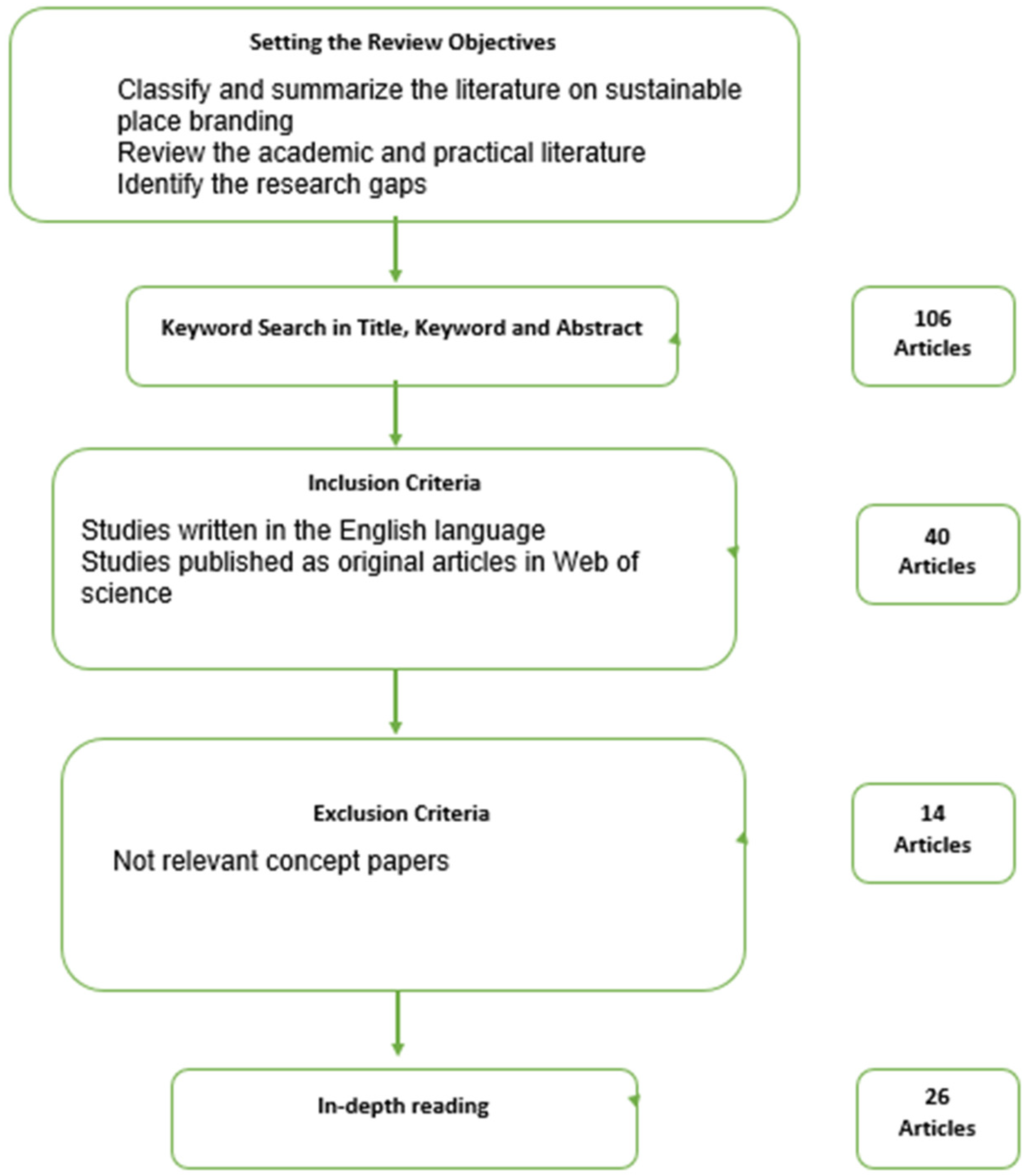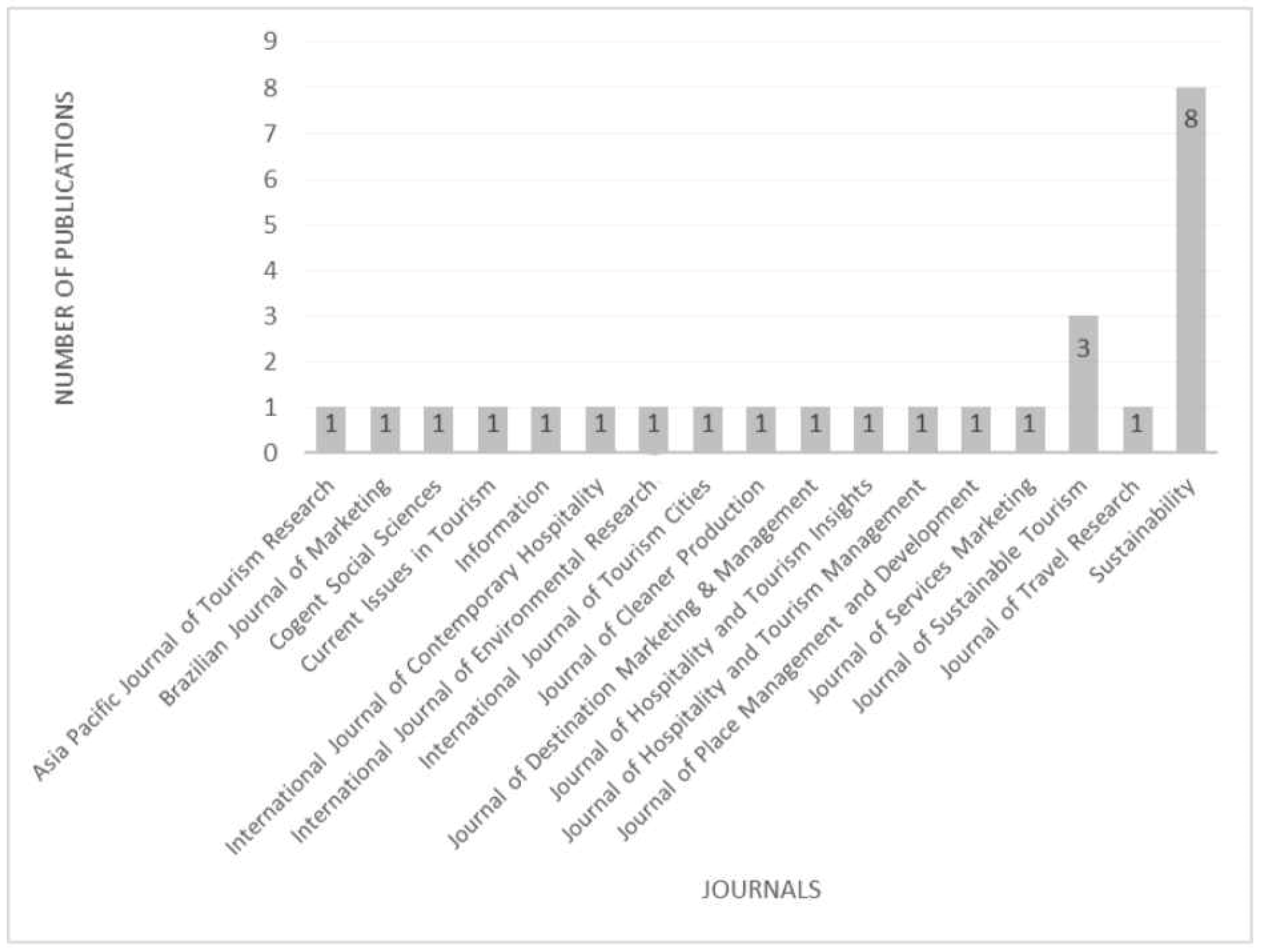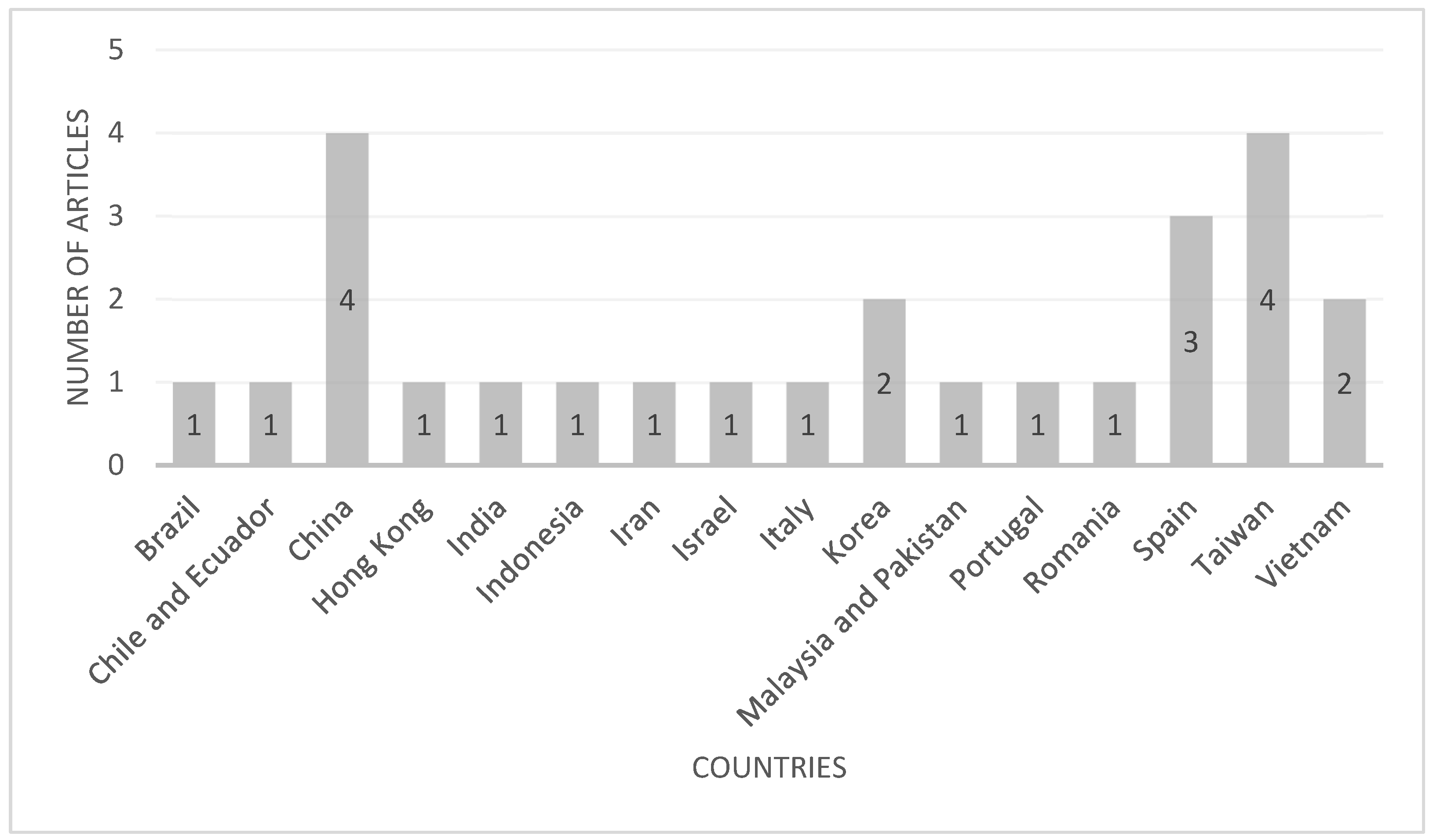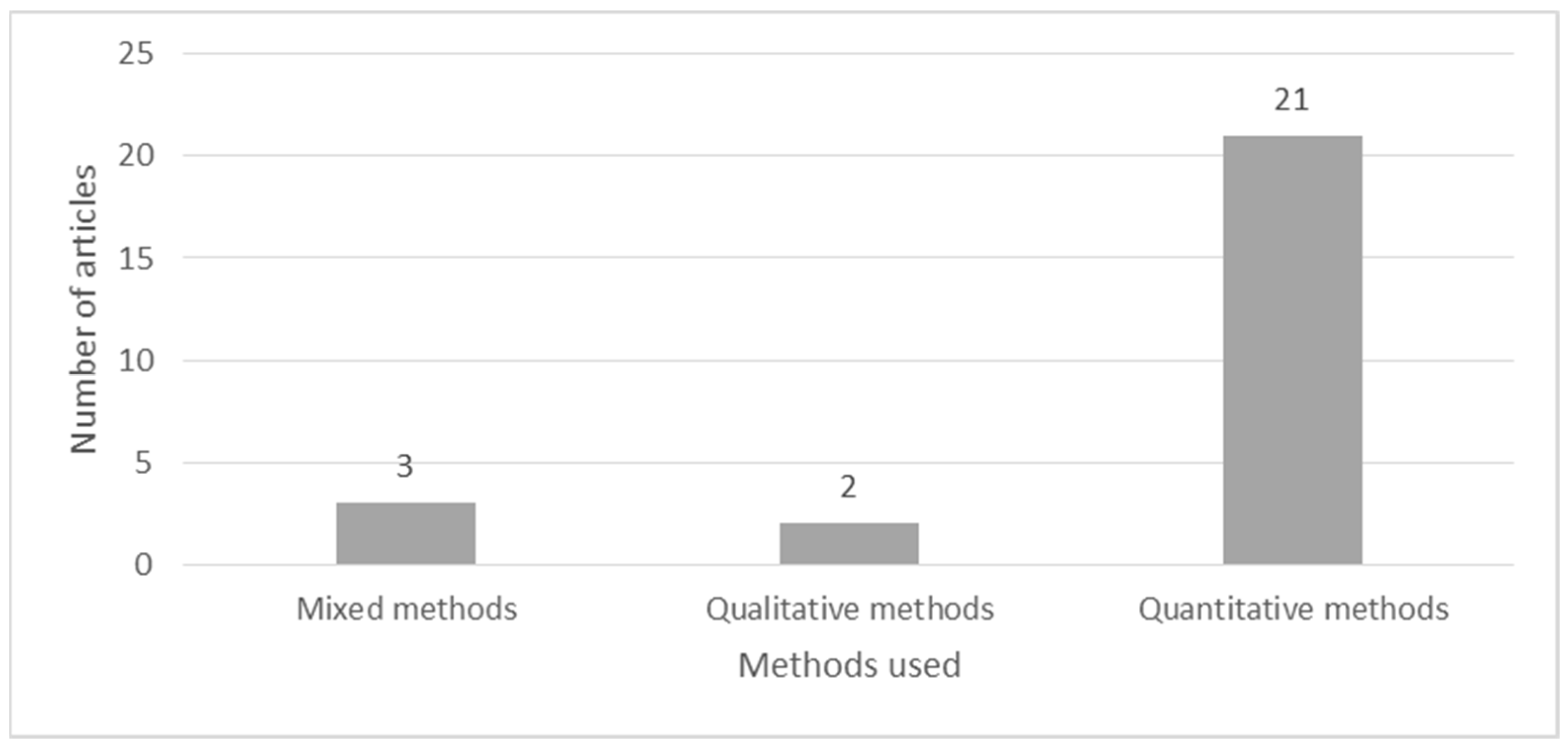Sustainable Place Branding and Visitors’ Responses: A Systematic Literature Review
Abstract
1. Introduction
- What are the current trends in sustainable destination branding and social destination responsibility?
- What is the trajectory of research findings based on the most relevant papers, research, and authors in the Web of Science database?
- What are the consequences of global research networks and partnerships, and how do co-authorship patterns among nations represent collaborations in sustainable place branding and visitor responses?
- What are the critical methodologies and approaches used in sustainable place branding and visitors’ response research?
- Based on the most common keywords, what are the main research clusters and theme topics, and how do these clusters further add knowledge on place branding sustainability and visitors’ responses?
2. Literature Review
3. Materials and Methods
3.1. Approach to the Literature Review
3.2. Validity of the Research Instrument, Search Strategy, Inclusion, and Exclusion Criteria
4. Results
4.1. Results from the Literature Analysis
4.2. Thematic Content Analysis
4.2.1. Sustainable Place Branding Creating Tourism Experiences and Engagement
4.2.2. Sustainable Place Creating Positive Brand Outcomes
4.2.3. Impact on Intention Visitors’ Loyalty and Positive Word of Mouth
5. Discussion and Conclusions
5.1. Summary of the Research Findings
5.2. Conclusions
5.3. Discussion
5.3.1. Implications for Practice
5.3.2. Directions for Future Research
5.4. Concluding Remarks
Supplementary Materials
Author Contributions
Funding
Institutional Review Board Statement
Informed Consent Statement
Data Availability Statement
Conflicts of Interest
References
- Qu, H.; Kim, L.H.; Im, H.H. A model of destination branding: Integrating the concepts of the branding and destination image. Tour. Manag. 2011, 32, 465–476. [Google Scholar] [CrossRef]
- Zenker, S.; Braun, E.; Petersen, S. Branding the destination versus the place: The effects of brand complexity and identification for residents and visitors. Tour. Manag. 2017, 58, 15–27. [Google Scholar] [CrossRef]
- Swain, S.; Jebarajakirthy, C.; Sharma, B.K.; Maseeh, H.I.; Agrawal, A.; Shah, J.; Saha, R. Place Branding: A Systematic Literature Review and Future Research Agenda. J. Travel Res. 2023, 63, 535–564. [Google Scholar] [CrossRef]
- Krabokoukis, T. Exploring the State of Research on Tourism Sustainability: A Bibliometric Analysis in the Post-COVID Era. Highlights Sustain. 2023, 2, 50–61. [Google Scholar] [CrossRef]
- Kotler, P.; Gertner, D. Country as brand, product, and beyond: A place marketing and brand management perspective. J. Brand Manag. 2002, 9, 249–261. [Google Scholar] [CrossRef]
- Anholt, S. Places; Palgrave Macmillan: London, UK, 2009. [Google Scholar]
- Govers, R.; Go, F. Place Branding; Palgrave Macmillan: London, UK, 2009. [Google Scholar]
- Seabra, C.; Bhatt, K. Tourism Sustainability and COVID-19 Pandemic: Is There a Positive Side? Sustainability 2022, 14, 8723. [Google Scholar] [CrossRef]
- Bourlon, F.; Gale, T.; Adiego, A.; Álvarez-Barra, V.; Salazar, A. Grounding Sustainable Tourism in Science—A Geographic Approach. Sustainability 2021, 13, 7455. [Google Scholar] [CrossRef]
- Markina, I.; Drogomyretska, M. The role of branding in the sustainable development of tourist destination. J. Res. Trade Manag. Econ. Dev. 2014, 2, 37–43. [Google Scholar]
- Therkelsen, A.; James, L.; Halkier, H. Place branding for sustainable development: The role of tourism in sustainable place branding strategies. In Marketing Countries, Places, and Place-Associated Brands; Edward Elgar Publishing: Northampton, MA, USA, 2021; pp. 319–336. [Google Scholar]
- Maheshwari, V.; Vandewalle, I.; Bamber, D. Place branding’s role in sustainable development. J. Place Manag. Dev. 2011, 4, 198–213. [Google Scholar] [CrossRef]
- Zouganeli, S.; Trihas, N.; Antonaki, M.; Kladou, S. Aspects of sustainability in the destination branding process: A bottom-up approach. J. Hosp. Mark. Manag. 2012, 21, 739–757. [Google Scholar] [CrossRef]
- Seguí-Amortegui, L.; Clemente-Almendros, J.A.; Medina, R.; Gala, M.G. Sustainability and Competitiveness in the Tourism Industry and Tourist Destinations: A Bibliometric Study. Sustainability 2019, 11, 6351. [Google Scholar] [CrossRef]
- Florek, M.; Hereźniak, M.; Augustyn, A. Measuring the effectiveness of city brand strategy. In search for a universal evaluative framework. Cities 2021, 110, 103079. [Google Scholar] [CrossRef]
- Gertner, D.; Kotler, P. How can a place correct a negative image? Place Brand. 2004, 1, 50–57. [Google Scholar] [CrossRef]
- Acharya, A.; Rahman, Z. Place branding research: A thematic review and future research agenda. Int. Rev. Public Nonprofit Mark. 2016, 13, 289–317. [Google Scholar] [CrossRef]
- Braun, E.; Kavaratzis, M.; Zenker, S. My city–my brand: The different roles of residents in place branding. J. Place Manag. Dev. 2013, 6, 18–28. [Google Scholar] [CrossRef]
- Briciu, V.A.; Briciu, A. Defining Place Branding through Local and National Identity and National Stereotypes. In Bulletin of the Transilvania University of Braşov. Series VII: Social Sciences • Law; Transilvania University of Braşov: Brașov, Romania, 2023; pp. 225–230. [Google Scholar] [CrossRef]
- Ntounis, N.; Kavaratzis, M. Re-branding the High Street: The place branding process and reflections from three UK towns. J. Place Manag. Dev. 2017, 10, 392–403. [Google Scholar] [CrossRef]
- Hanna, S.; Rowley, J.; Keegan, B. Place and Destination Branding: A Review and Conceptual Mapping of the Domain. Eur. Manag. Rev. 2020, 18, 105–117. [Google Scholar] [CrossRef]
- Papadopoulos, N.G.; Cleveland, M. Marketing Countries, Places, and Place-Associated Brands: Identity and Image; Edward Elgar Publishing: Northampton, MA, USA, 2021. [Google Scholar]
- Ekinci, Y.; Hosany, S. Destination personality: An application of brand personality to tourism destinations. J. Travel Res. 2006, 45, 127–139. [Google Scholar] [CrossRef]
- Apostolopoulou, A.; Papadimitriou, D. The role of destination personality in predicting tourist behaviour: Implications for branding mid-sized urban destinations. Curr. Issues Tour. 2015, 18, 1132–1151. [Google Scholar] [CrossRef]
- Rebelo, C.; Mehmood, A.; Marsden, T. Co-created visual narratives and inclusive place branding: A socially responsible approach to residents’ participation and engagement. Sustain. Sci. 2019, 15, 423–435. [Google Scholar] [CrossRef]
- Govers, R. From place marketing to place branding and back. Place Brand. Public Dipl. 2011, 7, 227–231. [Google Scholar] [CrossRef]
- Fan, Y. 2010 Branding the nation: Towards a better understanding. Place Brand. Public Dipl. 2010, 6, 97–103. [Google Scholar] [CrossRef]
- de Bruyn, C.; Said, F.B.; Meyer, N.; Soliman, M. Research in tourism sustainability: A comprehensive bibliometric analysis from 1990 to 2022. Heliyon 2023, 9, e18874. [Google Scholar] [CrossRef] [PubMed]
- Liasidou, S.; Fella, K.; Stylianou, C. A sustainable destination is an accessible destination: Examining the relationship as a remedy to seasonality. Worldw. Hosp. Tour. Themes 2022, 14, 481–491. [Google Scholar] [CrossRef]
- Ruiz, E.C.; De la Cruz, E.R.R.; Vázquez, F.J.C. Sustainable tourism and residents’ perception towards the brand: The case of Malaga (Spain). Sustainability 2019, 11, 292. [Google Scholar] [CrossRef]
- Santos, V.; Sousa, M.J.; Costa, C.; Au-Yong-Oliveira, M. Tourism towards Sustainability and Innovation: A Systematic Literature Review. Sustainability 2021, 13, 11440. [Google Scholar] [CrossRef]
- Streimikiene, D.; Svagzdiene, B.; Jasinskas, E.; Simanavicius, A. Sustainable tourism development and com-petitiveness: The systematic literature review. Sustain. Dev. 2021, 29, 259–271. [Google Scholar] [CrossRef]
- Su, L.; Swanson, S.R. The effect of destination social responsibility on tourist environmentally responsible be-havior: Compared analysis of first-time and repeat tourists. Tour. Manag. 2017, 60, 308–321. [Google Scholar] [CrossRef]
- Su, L.; Gong, Q.; Huang, Y. How do destination social responsibility strategies affect tourists’ intention to visit? An attribution theory perspective. J. Retail. Consum. Serv. 2020, 54, 102023. [Google Scholar] [CrossRef]
- Su, L.; Lian, Q.; Huang, Y. How do tourists’ attribution of destination social responsibility motives impact trust and intention to visit? The moderating role of destination reputation. Tour. Manag. 2020, 77, 103970. [Google Scholar] [CrossRef]
- Florek, M. Search of a Place Brand Identity Model; Edward Elgar Publishing eBooks: Northampton, MA, USA, 2021. [Google Scholar] [CrossRef]
- Papagiannakis, G.E.; Vlachos, P.A.; Koritos, C.D.; Kassinis, G.I. Are publicly traded tourism and hospitality providers greenwashing? Tour. Manag. 2024, 103, 104893. [Google Scholar] [CrossRef]
- Agapito, D.; Kronenburg, R.; Pinto, P. A review on destination social responsibility: Towards a research agenda. Curr. Issues Tour. 2022, 26, 554–572. [Google Scholar] [CrossRef]
- Kumar, R.; Jebarajakirthy, C.; Maseeh, H.I.; Dhanda, K.; Saha, R.; Dahiya, R. Two decades of brand hate research: A review and research agenda. Mark. Intell. Plan. 2023, 41, 763–789. [Google Scholar] [CrossRef]
- Moher, D.; Liberati, A.; Tetzlaff, J.; Altman, D.G.; PRISMA Group. Preferred reporting items for systematic reviews and meta-analyses: The PRISMA statement. Ann. Intern. Med. 2009, 151, 264–269. [Google Scholar] [CrossRef] [PubMed]
- Katrandjiev, H. Ecological marketing, green marketing, sustainable marketing: Synonyms or an evolution of ideas. Econ. Altern. 2016, 1, 71–82. [Google Scholar]
- Shaheen, N.; Shaheen, A.; Ramadan, A.; Hefnawy, M.T.; Ramadan, A.; Ibrahim, I.A.; Hassanein, M.E.; Ashour, M.E.; Flouty, O. Appraising systematic reviews: A comprehensive guide to ensuring validity and reliability. Front. Res. Metr. Anal. 2023, 8, 1268045. [Google Scholar] [CrossRef] [PubMed]
- Atkinson, L.Z.; Andrea, C. How to carry out a literature search for a systematic review: A practical guide. BJPsych Adv. 2018, 24, 74–82. [Google Scholar] [CrossRef]
- Caiado, R.G.G.; de Freitas Dias, R.; Mattos, L.V.; Quelhas, O.L.G.; Leal Filho, W. Towards sustainable development through the perspective of eco-efficiency-A systematic literature review. J. Clean. Prod. 2017, 165, 890–904. [Google Scholar] [CrossRef]
- Gonçalves, J.; Mateus, R.; Silvestre, J.D.; Roders, A.P. Going beyond good intentions for the sustainable conservation of built heritage: A systematic literature review. Sustainability 2020, 12, 9649. [Google Scholar] [CrossRef]
- Trindade, E.P.; Hinnig, M.P.F.; da Costa, E.M.; Marques, J.S.; Bastos, R.C.; Yigitcanlar, T. Sustainable development of smart cities: A systematic review of the literature. J. Open Innov. Technol. Mark. Complex. 2017, 3, 1–14. [Google Scholar] [CrossRef]
- Chen, C.M.; Chen, S.H.; Lee, H.T. The destination competitiveness of Kinmen’s tourism industry: Exploring the interrelationships between tourist perceptions, service performance, customer satisfaction and sustainable tourism. J. Sustain. Tour. 2011, 19, 247–264. [Google Scholar] [CrossRef]
- Mardievna, S.G.; Qizi, A.M.A. The Role of Tourism in the Development of the Country’s Economy. Cent. Asian J. Innov. Tour. Manag. Financ. 2024, 5, 7–12. [Google Scholar]
- Bunghez, C.L. The emerging trend of niche tourism: Impact analysis. J. Mark. Res. Case Stud. 2021, 2021, 134710. [Google Scholar] [CrossRef]
- Gelbman, A. Tourist experience and innovative hospitality management in different cities. Sustainability 2021, 13, 6578. [Google Scholar] [CrossRef]
- Nistoreanu, P.; Aluculesei, A.C.; Avram, D. Is green marketing a label for ecotourism? The Romanian experience. Information 2020, 11, 389. [Google Scholar] [CrossRef]
- Zhou, X.; Tang, C.; Lv, X.; Xing, B. Visitor engagement, relationship quality, and environmentally responsible behavior. Int. J. Environ. Res. Public Health 2020, 17, 1151. [Google Scholar] [CrossRef] [PubMed]
- Pourhossein, M.; Baker, B.J.; Dousti, M.; Behnam, M.; Tabesh, S. Embarking on the trail of sustainable harmony: Exploring the nexus of visitor environmental engagement, awareness, and destination social responsibility in natural parks. J. Destin. Mark. Manag. 2023, 30, 100821. [Google Scholar] [CrossRef]
- Saleem, M.A.; Li, J.; Afzal, H. Protect for affinity? The role of destination brand engagement in forming environmentally responsible tourist behaviours. J. Sustain. Tour. 2021, 29, 1344–1364. [Google Scholar] [CrossRef]
- Chan, C.S.; Peters, M.; Pikkemaat, B. Investigating visitors’ perception of smart city dimensions for city branding in Hong Kong. Int. J. Tour. Cities 2019, 5, 620–638. [Google Scholar] [CrossRef]
- Mariani, M.M.; Guizzardi, A. Does designation as a UNESCO world heritage site influence tourist evaluation of a local destination? J. Travel Res. 2020, 59, 22–36. [Google Scholar] [CrossRef]
- Yu, C.; Hwang, Y.S. Do the social responsibility efforts of the destination affect the loyalty of tourists? Sustainability 2019, 11, 1998. [Google Scholar] [CrossRef]
- Rodrigues, P.; Borges, A.P.; Vieira, E.P. Corporate social responsibility image and emotions for the competitiveness of tourism destinations. J. Place Manag. Dev. 2021, 14, 134–147. [Google Scholar] [CrossRef]
- Gómez-Suárez, M.; Yagüe, M.J. Making sense from experience: How a sustainable multi-sensory event spurs word-of-mouth recommendation of a destination brand. Sustainability 2021, 13, 5873. [Google Scholar] [CrossRef]
- Polo Pena, A.I.; Frias Jamilena, D.M.; Rodriguez Molina, M.A. The effect of a destination branding strategy for rural tourism on the perceived value of the conservation of the indigenous resources of the rural tourism destination: The case of Spain. Curr. Issues Tour. 2013, 16, 129–147. [Google Scholar] [CrossRef]
- Yang, J.J.; Iyer, R.; Lee, Y.K. Why Do Local Foodscapes Matter in Building Tourist Trust and Loyalty? Sustainability 2022, 14, 2029. [Google Scholar] [CrossRef]
- Wang, K.Y. Sustainable Tourism Development Based upon Visitors’ Brand Trust: A Case of “100 Religious Attractions”. Sustainability 2022, 14, 1977. [Google Scholar] [CrossRef]
- Wong, I.A.; Ruan, W.J.; Cai, X.; Huang, G.I. Green-Induced tourist equity: The cross-level effect of regional environmental performance. J. Sustain. Tour. 2021, 29, 1043–1062. [Google Scholar] [CrossRef]
- Rosenbaum, M.S.; Wong, I.A. Green marketing programs as strategic initiatives in hospitality. J. Serv. Mark. 2015, 29, 81–92. [Google Scholar] [CrossRef]
- Shen, C.C.; Chang, Y.R.; Liu, D.J. Sustainable development of an organic agriculture village to explore the influential effect of brand equity from the perspective of landscape resources. Sustainability 2020, 12, 7416. [Google Scholar] [CrossRef]
- Chi, N.T.K. Understanding the effects of eco-label, eco-brand, and social media on green consumption intention in ecotourism destinations. J. Clean. Prod. 2021, 321, 128995. [Google Scholar] [CrossRef]
- Kim, M.S.; Thapa, B.; Kim, H. International Tourists’ Perceived Sustainability of Jeju Island, South Korea. Sustainability 2017, 10, 73. [Google Scholar] [CrossRef]
- Huang, Y.C.; Liu, C.H.S. Moderating and mediating roles of environmental concern and ecotourism experience for revisit intention. Int. J. Contemp. Hosp. Manag. 2017, 29, 1854–1872. [Google Scholar] [CrossRef]
- Lee, S.W.; Xue, K. A model of destination loyalty: Integrating destination image and sustainable tourism. Asia Pac. J. Tour. Res. 2020, 25, 393–408. [Google Scholar] [CrossRef]
- Nukhu, R.; Singh, S. Is satisfaction a moderator? The effect of sensory experience on perceived environmental sustainability and WOM: A study on the world’s first organic state–Sikkim, India. J. Hosp. Tour. Insights 2024, 7, 479–499. [Google Scholar] [CrossRef]
- Zakiah, S.; Winarno, A.; Hermana, D. Examination of consumer engagement for loyalty in sustainable destination image. Cogent Soc. Sci. 2023, 9, 2269680. [Google Scholar] [CrossRef]
- Page, M.J.; McKenzie, J.E.; Bossuyt, P.M.; Boutron, I.; Hoffmann, T.C.; Mulrow, C.D.; Shamseer, L.; Tetzlaff, J.M.; Akl, E.A.; Brennan, S.E.; et al. The PRISMA 2020 statement: An updated guideline for reporting systematic reviews. BMJ 2021, 372, n71. [Google Scholar] [CrossRef]






Disclaimer/Publisher’s Note: The statements, opinions and data contained in all publications are solely those of the individual author(s) and contributor(s) and not of MDPI and/or the editor(s). MDPI and/or the editor(s) disclaim responsibility for any injury to people or property resulting from any ideas, methods, instructions or products referred to in the content. |
© 2024 by the authors. Licensee MDPI, Basel, Switzerland. This article is an open access article distributed under the terms and conditions of the Creative Commons Attribution (CC BY) license (https://creativecommons.org/licenses/by/4.0/).
Share and Cite
Garanti, Z.; Ilkhanizadeh, S.; Liasidou, S. Sustainable Place Branding and Visitors’ Responses: A Systematic Literature Review. Sustainability 2024, 16, 3312. https://doi.org/10.3390/su16083312
Garanti Z, Ilkhanizadeh S, Liasidou S. Sustainable Place Branding and Visitors’ Responses: A Systematic Literature Review. Sustainability. 2024; 16(8):3312. https://doi.org/10.3390/su16083312
Chicago/Turabian StyleGaranti, Zanete, Shiva Ilkhanizadeh, and Sotiroula Liasidou. 2024. "Sustainable Place Branding and Visitors’ Responses: A Systematic Literature Review" Sustainability 16, no. 8: 3312. https://doi.org/10.3390/su16083312
APA StyleGaranti, Z., Ilkhanizadeh, S., & Liasidou, S. (2024). Sustainable Place Branding and Visitors’ Responses: A Systematic Literature Review. Sustainability, 16(8), 3312. https://doi.org/10.3390/su16083312



_Li.png)


